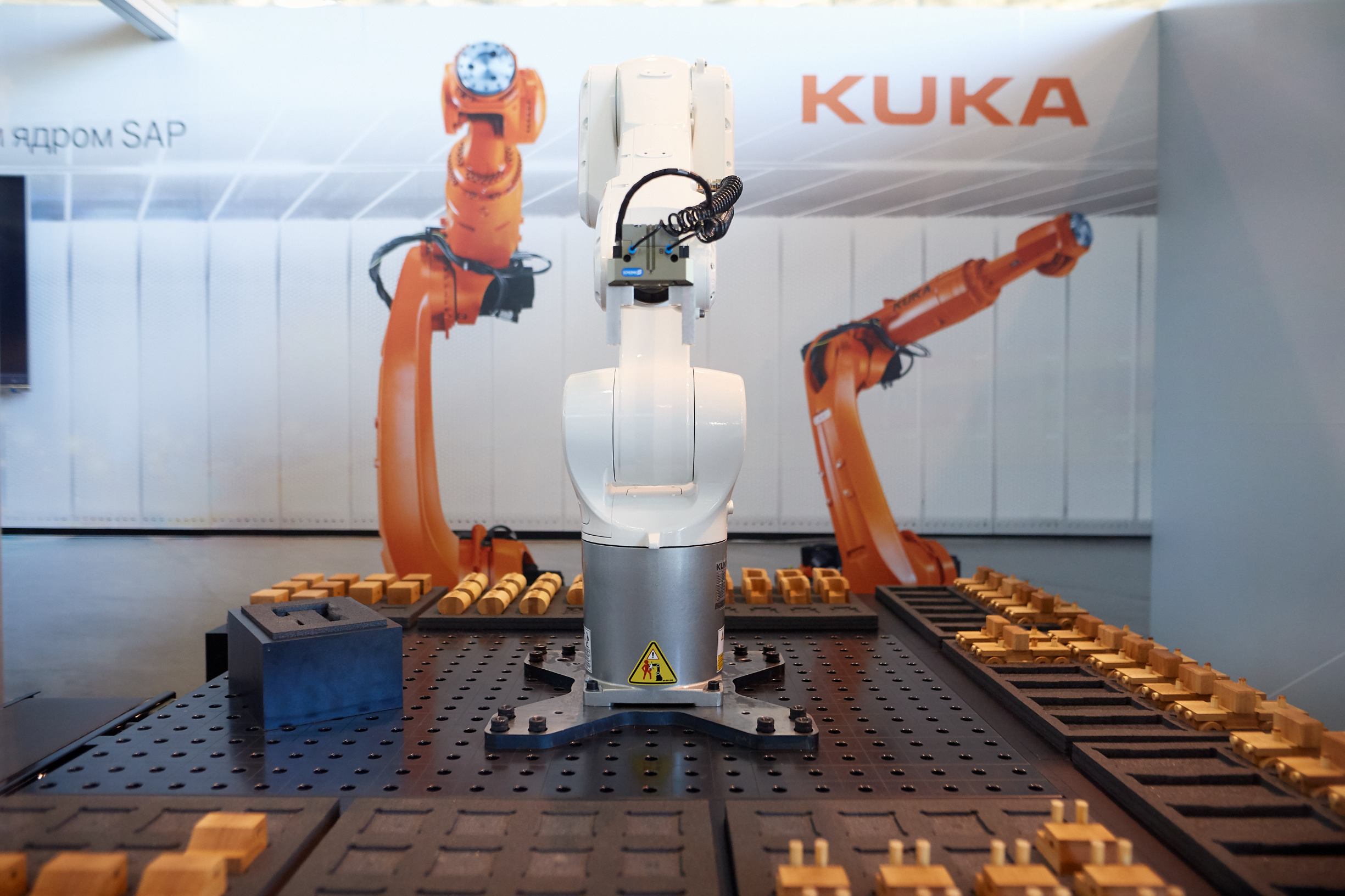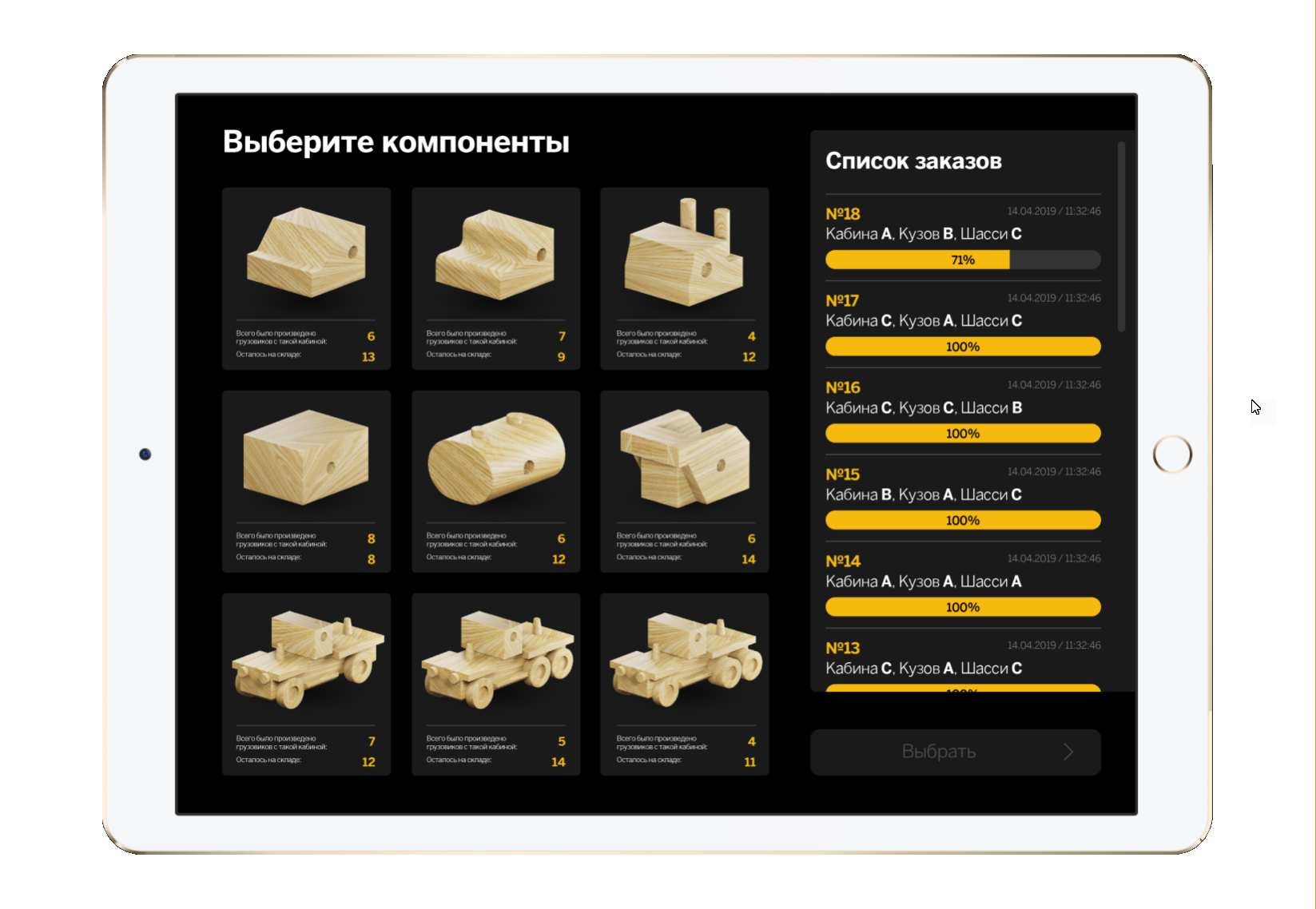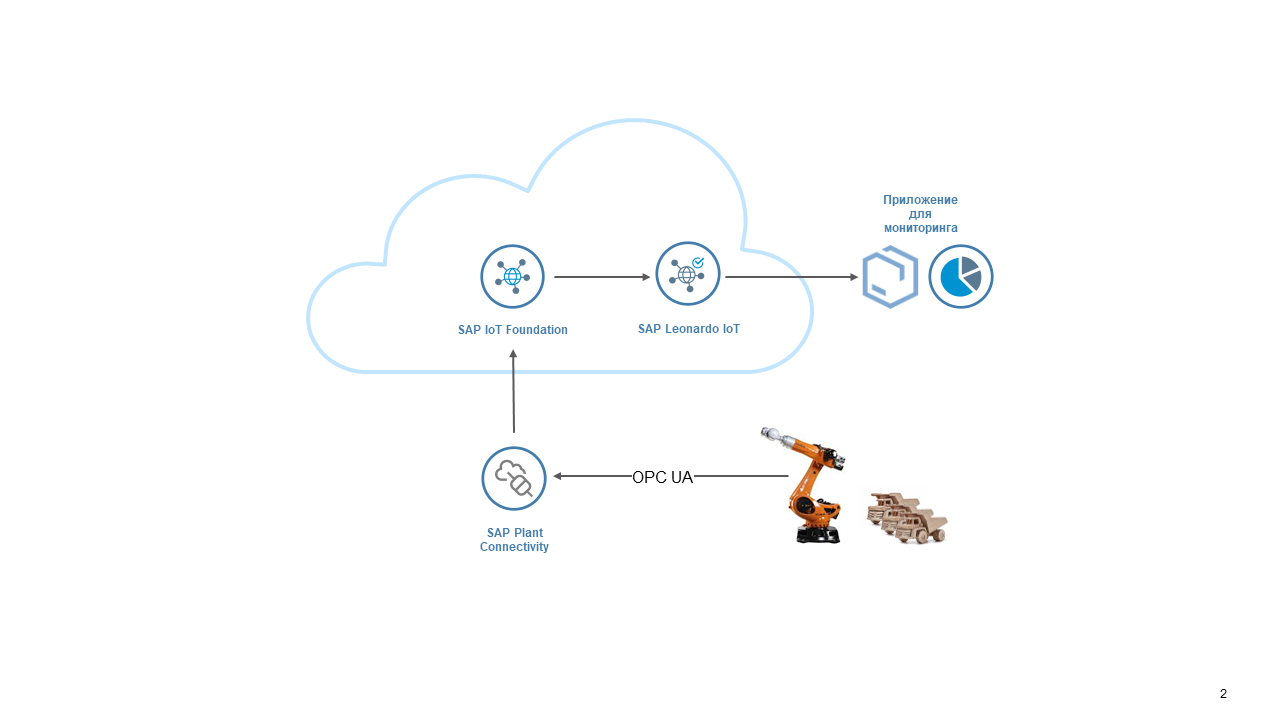Industry 4.0: Autonomous Enterprise Ideas from SAP and KUKA
Hello, Habr!
Today we’ll talk about the automation of technological “smart” equipment, which is becoming more and more in modern enterprises. It can easily be integrated with accounting and management systems of SAP to create a single software and hardware complex. In our opinion, this perfectly demonstrates the concept of industry 4.0 and brings our industry closer to realizing the idea of an autonomous enterprise.
KUKA, one of the SAP partners, produces high-tech hardware, namely industrial robots, which are easily integrated into a single control loop and allow for a relatively short time and cost to achieve a high degree of autonomy of the production unit.
Consider an example of integration - a robotic arm that assembled small truck models from several options of parts - to choose from (Fig. 1). The client created the order in the familiar interface of the web store, making up the vehicle equipment. The robot received the order and executed it. At the same time, he independently found parts for the selected configuration and assembled a car model.

Figure 1. KUKA Robot Layout
At first glance, the whole structure was quite simple, because industrial robots have been used in production for decades and have become a familiar element of the interior of the assembly shop, but it is not so simple.
Intelligent Enterprise Concept
One of the foundations of the Industry 4.0 concept is the concept of an Intelligent Enterprise. If we consider it as a single living organism, then the digital core of SAP plays the role of its central nervous system. But, like any organism in living nature, the enterprise must interact with the environment, receiving tasks from it, knowledge about the environment, influencing it. Here a single "organism" was created, the "hands" and "eyes" of which are the industrial manipulator of KUKA. KUKA “Hand” receives tasks for execution from the “brain” of our single organism, performs tasks, collects information about the environment and its own condition, and constantly supplies it with a decision center. The “brain” accumulates information and “takes care” of its hands and eyes, constantly evaluating their condition and preventing possible “diseases”. Integration of solution elements similar to those shown allows us to approach the creation of 100% automated production zones, warehouses, order assembly zones, etc.
In fact, the “robot” or, rather, the robot plant in this solution was a geographically distributed complex. It consisted of a mobile client terminal, in the hands of the customer, managing the core based on the cloud SAP S / 4HANA, which is installed in one of the SAP data centers scattered around the globe, as well as the KUKA production cell, which (as well as its copies) can be installed where the raw materials or customers are located. At the same time, information on the consumption of components, the number of vehicles collected, shipments and other business indicators are sent to SAP S / 4HANA for full financial and material accounting in real time. The only person who worked at this plant was a customer creating an order for his vehicle.
How does it work?
In this scenario, two information flows were provided. First, production - the main. Through it, control actions were transferred to the manipulator and the execution status of a specific order was removed. The assembly flow chart was stored in the SAP S / 4HANA production module. To integrate the accounting system with the world of industrial devices, SAP Manufacturing Integration and Intelligence (MII) was used. This solution also served as the platform on which the client terminal was developed. The client application interface is implemented on the standard SAP UI5 framework with a highly customized style sheet (Fig. 2).

Figure 2
Integration of SAP MII directly with the manipulator was carried out “on the ground” using the software component SAP Plant Connectivity (PCo), which supports a number of protocols for the industrial Internet of things, and in particular, OPC UA, the server of which is KUKA robot software. It should be noted that the process of integration of systems of two vendors and different classes took several hours and the main efforts were focused on creating client interfaces.
KUKA specialists developed high-level assembly control teams, the codes of which were contained in the SAP routing. Commands via PCo were recorded in the control tags of the OPC server of the manipulator, information about the status of completion of a subprocess was returned back, which made it possible to visualize the progress of the order in real time (Fig. 3).

Figure 3 “Production” information exchange
The second information stream, service - is the collection of telemetry information from the robot. The manipulator has hundreds of parameters that make it possible to evaluate its state both in real time and using historically accumulated data. In this scenario, the values of the OPC server variables passed through Plant Connectivity to the SAP Cloud Platform Internet of Things cloud, where the device’s digital double was created. Data was automatically accumulated and could serve as a “raw material” for a wide variety of applications: we can use streaming analytics to identify patterns of indicators and generate some business events on their basis, such as a malfunction state or an out-of-band operation mode of a robot.
An even more interesting application of the collected data is its processing using machine learning algorithms and the implementation of predictive maintenance scenarios on this basis. These scenarios are standardly implemented by SAP products. However, in the framework of this integration project, the main scenario was production, so the service exchange (Fig. 4) was implemented as an application for visual monitoring of the main indicators of the robot. The application was developed using the cloud service of rapid development of IoT applications SAP Leonardo IoT.

Figure 4 “Service” information exchange
Another successful integration experience shows that, in general, information technologies and their individual elements are completely ready to build industrial solutions in the Industry 4.0 paradigm. We often hear stories about “a batch of one copy”, “production without people”, “mass production on order” Similar decisions arise, including in the vastness of our country. SAP actively promotes and implements the approach of the Intellectual Enterprise, and the existing set of technologies now allows you to build enterprises as full-fledged cyberphysical organisms. Where this will lead to - see pretty soon.
Anton Nozdrin, SAP CIS Business Solutions Architect
Today we’ll talk about the automation of technological “smart” equipment, which is becoming more and more in modern enterprises. It can easily be integrated with accounting and management systems of SAP to create a single software and hardware complex. In our opinion, this perfectly demonstrates the concept of industry 4.0 and brings our industry closer to realizing the idea of an autonomous enterprise.
KUKA, one of the SAP partners, produces high-tech hardware, namely industrial robots, which are easily integrated into a single control loop and allow for a relatively short time and cost to achieve a high degree of autonomy of the production unit.
Consider an example of integration - a robotic arm that assembled small truck models from several options of parts - to choose from (Fig. 1). The client created the order in the familiar interface of the web store, making up the vehicle equipment. The robot received the order and executed it. At the same time, he independently found parts for the selected configuration and assembled a car model.

Figure 1. KUKA Robot Layout
At first glance, the whole structure was quite simple, because industrial robots have been used in production for decades and have become a familiar element of the interior of the assembly shop, but it is not so simple.
Intelligent Enterprise Concept
One of the foundations of the Industry 4.0 concept is the concept of an Intelligent Enterprise. If we consider it as a single living organism, then the digital core of SAP plays the role of its central nervous system. But, like any organism in living nature, the enterprise must interact with the environment, receiving tasks from it, knowledge about the environment, influencing it. Here a single "organism" was created, the "hands" and "eyes" of which are the industrial manipulator of KUKA. KUKA “Hand” receives tasks for execution from the “brain” of our single organism, performs tasks, collects information about the environment and its own condition, and constantly supplies it with a decision center. The “brain” accumulates information and “takes care” of its hands and eyes, constantly evaluating their condition and preventing possible “diseases”. Integration of solution elements similar to those shown allows us to approach the creation of 100% automated production zones, warehouses, order assembly zones, etc.
In fact, the “robot” or, rather, the robot plant in this solution was a geographically distributed complex. It consisted of a mobile client terminal, in the hands of the customer, managing the core based on the cloud SAP S / 4HANA, which is installed in one of the SAP data centers scattered around the globe, as well as the KUKA production cell, which (as well as its copies) can be installed where the raw materials or customers are located. At the same time, information on the consumption of components, the number of vehicles collected, shipments and other business indicators are sent to SAP S / 4HANA for full financial and material accounting in real time. The only person who worked at this plant was a customer creating an order for his vehicle.
How does it work?
In this scenario, two information flows were provided. First, production - the main. Through it, control actions were transferred to the manipulator and the execution status of a specific order was removed. The assembly flow chart was stored in the SAP S / 4HANA production module. To integrate the accounting system with the world of industrial devices, SAP Manufacturing Integration and Intelligence (MII) was used. This solution also served as the platform on which the client terminal was developed. The client application interface is implemented on the standard SAP UI5 framework with a highly customized style sheet (Fig. 2).

Figure 2
Integration of SAP MII directly with the manipulator was carried out “on the ground” using the software component SAP Plant Connectivity (PCo), which supports a number of protocols for the industrial Internet of things, and in particular, OPC UA, the server of which is KUKA robot software. It should be noted that the process of integration of systems of two vendors and different classes took several hours and the main efforts were focused on creating client interfaces.
KUKA specialists developed high-level assembly control teams, the codes of which were contained in the SAP routing. Commands via PCo were recorded in the control tags of the OPC server of the manipulator, information about the status of completion of a subprocess was returned back, which made it possible to visualize the progress of the order in real time (Fig. 3).

Figure 3 “Production” information exchange
The second information stream, service - is the collection of telemetry information from the robot. The manipulator has hundreds of parameters that make it possible to evaluate its state both in real time and using historically accumulated data. In this scenario, the values of the OPC server variables passed through Plant Connectivity to the SAP Cloud Platform Internet of Things cloud, where the device’s digital double was created. Data was automatically accumulated and could serve as a “raw material” for a wide variety of applications: we can use streaming analytics to identify patterns of indicators and generate some business events on their basis, such as a malfunction state or an out-of-band operation mode of a robot.
An even more interesting application of the collected data is its processing using machine learning algorithms and the implementation of predictive maintenance scenarios on this basis. These scenarios are standardly implemented by SAP products. However, in the framework of this integration project, the main scenario was production, so the service exchange (Fig. 4) was implemented as an application for visual monitoring of the main indicators of the robot. The application was developed using the cloud service of rapid development of IoT applications SAP Leonardo IoT.

Figure 4 “Service” information exchange
Another successful integration experience shows that, in general, information technologies and their individual elements are completely ready to build industrial solutions in the Industry 4.0 paradigm. We often hear stories about “a batch of one copy”, “production without people”, “mass production on order” Similar decisions arise, including in the vastness of our country. SAP actively promotes and implements the approach of the Intellectual Enterprise, and the existing set of technologies now allows you to build enterprises as full-fledged cyberphysical organisms. Where this will lead to - see pretty soon.
Anton Nozdrin, SAP CIS Business Solutions Architect
All Articles